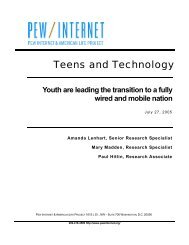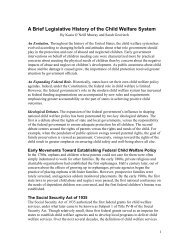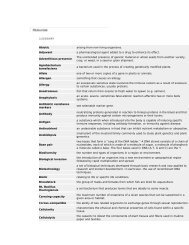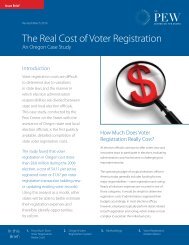Protecting Western Australia's Big Blue Backyard - The Pew ...
Protecting Western Australia's Big Blue Backyard - The Pew ...
Protecting Western Australia's Big Blue Backyard - The Pew ...
Create successful ePaper yourself
Turn your PDF publications into a flip-book with our unique Google optimized e-Paper software.
2<br />
EXECUTIVE SUMMARY<br />
<strong>Protecting</strong> <strong>Western</strong> Australia’s big blue backyard<br />
is the first report by Save our Marine Life,<br />
a new collaboration of global, national and<br />
state-based environment organisations that<br />
is built around a common vision to conserve<br />
Australia’s unique marine life through working<br />
with local communities, governments, industry<br />
stakeholders and Traditional Owners to secure<br />
a Comprehensive, Adequate and Representative<br />
(CAR) network of large no-take reserves in<br />
Australia’s marine environment.<br />
A Comprehensive conservation reserve network<br />
is one in which all major bioregions have<br />
reserves within them. Adequate refers to the<br />
number, size, configuration and level<br />
of protection of the reserves within a bioregion.<br />
<strong>The</strong> reserves also need to be Representative<br />
of the ecosystems within the bioregions.<br />
<strong>The</strong> Conservation Council of <strong>Western</strong> Australia,<br />
the Australian Conservation Foundation,<br />
<strong>The</strong> Wilderness Society, WWF-Australia,<br />
the Australian Marine Conservation Society,<br />
<strong>The</strong> Nature Conservancy and the <strong>Pew</strong><br />
Environment Group have established the<br />
Save our Marine Life Collaboration.<br />
<strong>The</strong> area of focus for the Collaboration’s first<br />
report, <strong>Protecting</strong> <strong>Western</strong> Australia’s big<br />
blue backyard, is the southern half of <strong>Western</strong><br />
Australia’s immense coastline, from Kalbarri to<br />
Eucla. This is the <strong>Western</strong> Australian component<br />
of the South-west Marine Region currently being<br />
considered for protection by the Australian<br />
Government under its National Representative<br />
System of Marine Protected Areas.<br />
<strong>The</strong> marine environment from Kalbarri to Eucla<br />
is globally significant for its unique and threatened<br />
species, underwater features and ecosystems<br />
including:<br />
– globally high levels of unique marine species<br />
(70–90 per cent found nowhere else on Earth)<br />
as a result of geological isolation, an unusual<br />
major southerly current bringing temperate<br />
and tropical species together, and a history<br />
free of major environmental disturbance in<br />
geological time<br />
– a series of hotspots for marine life including the<br />
Houtman-Abrolhos Islands, the Perth Canyon,<br />
Geographe Bay, Cape Mentelle, the Naturaliste<br />
Plateau, the Diamantina Fracture Zone, the<br />
Albany Canyons and the Recherche Archipelago<br />
– critical habitat for a range of significant species<br />
including the world’s largest animal, the<br />
endangered blue whale. Perth Canyon is one of<br />
only two blue whale feeding grounds known in<br />
Australia. It is a key to the survival and recovery<br />
of blue whales<br />
– one of the world’s largest sharks, the threatened<br />
white shark; and the world’s largest marine turtle,<br />
the endangered leatherback turtle<br />
– a greater southerly range for major tropical coral<br />
reefs than anywhere else in the Indian Ocean<br />
– an unusual collection of fish life and habitats<br />
as a result of low nutrients, clear water due to<br />
limited river runoff, and waters warmer than are<br />
normally found so far south<br />
– geologically and ecologically significant<br />
subsea features including the deepest point<br />
in Australia’s oceans, an island under the<br />
sea—a large submerged fragment of continental<br />
shelf—Australia’s highest underwater mountain<br />
range, and Australia’s largest marine canyon.<br />
A highly unusual and globally significant current<br />
is the life force of this region. At 5500 kilometres<br />
in length, the Leeuwin Current is the world’s<br />
longest continuous coastal current, and its journey<br />
along the <strong>Western</strong> Australian coast connects<br />
and supports the key elements of the protection<br />
blueprint outlined in this report.<br />
With less than five per cent of the region’s marine<br />
environment explored, the region is in the midst<br />
of an exciting new phase of scientific discovery,<br />
with vast numbers of new species being found<br />
with each research voyage.<br />
<strong>The</strong> region’s unusual ecological characteristics<br />
make it both vulnerable to climate change<br />
and important as a potential source of refugia<br />
for species. <strong>The</strong>se include tropical corals and<br />
associated marine life with ranges that may shift<br />
south in the face of climate change that warms<br />
their existing habitats to the north.<br />
Of all Australian states, <strong>Western</strong> Australia<br />
is particularly dependent on its vast marine<br />
environment. <strong>The</strong> marine life of the Kalbarri<br />
to Eucla region has underpinned the State’s<br />
social, cultural and economic development and<br />
will continue to be relied upon into the future.<br />
Marine-based recreation, tourism and trade<br />
are significant economic drivers. Australia’s most<br />
lucrative fishery, the western rock lobster fishery,<br />
is found in this region, and the oil and gas<br />
industry appears to be on the cusp of a<br />
significant expansion.<br />
With 90 per cent of the world’s large predatory fish<br />
already gone, no nation can be complacent about<br />
its use of living marine resources. Commercial<br />
and recreational fishing in this region is placing<br />
enormous pressure on popular fish species.<br />
Monitoring in many no-take areas around the<br />
world has shown fish abundance is higher in<br />
no-take reserves than in areas that continue to<br />
be fished. Research by the Australian Institute<br />
of Marine Science and James Cook University<br />
confirmed this for the Great Barrier Reef Marine<br />
Park in 2008. <strong>The</strong> coral trout, for example,<br />
has been found to be twice as abundant in<br />
some of the no-take zones as it is in fished areas.<br />
Despite the critical importance of the region to<br />
<strong>Western</strong> Australia and the nation, its unique and<br />
relatively intact nature, and the increasing impacts<br />
and threats from use, levels of protection are<br />
inadequate. Less than one per cent of the region<br />
is secured in any type of marine protected area.<br />
This is in contrast to the protection afforded the<br />
eastern seaboard of Australia and Australia’s<br />
global commitment to manage and conserve the<br />
huge marine environment in its care.<br />
Australia values highly its international leadership<br />
position in the conservation of marine life and<br />
habitats. This is demonstrated by our commitment<br />
to the Convention on Biological Diversity and<br />
other important international conventions.<br />
In order to maintain that standing, Australia’s<br />
challenge is to implement the expert international<br />
recommendation that all nations establish<br />
networks of no-take areas covering at least<br />
20–30 per cent of each marine habitat. As little<br />
as four per cent of Australia’s marine environment<br />
is afforded no-take protection.<br />
Recent polling shows that <strong>Western</strong> Australians<br />
view marine protection as highly important.<br />
Of those polled, 73 per cent saw marine protection<br />
as very important, 75 per cent felt there was not<br />
enough marine protection in WA, and almost<br />
50 per cent called for protection to cover at least<br />
30 per cent of the marine environment.<br />
<strong>Protecting</strong> <strong>Western</strong> Australia’s big blue backyard<br />
concludes that a CAR network of large no-take<br />
marine reserves is needed now to secure the future<br />
of marine life, industries and people in the Kalbarri<br />
to Eucla region. Non-extractive uses of these areas<br />
such as diving, scientific exploration, ecotourism,<br />
education, shipping and sailing will continue and<br />
benefit from improved marine health.<br />
<strong>The</strong> prime responsibility to act sits with the<br />
Australian Government, which is responsible<br />
for managing almost all of Australia’s marine<br />
environment including that off the coast of<br />
<strong>Western</strong> Australia.<br />
<strong>Protecting</strong> <strong>Western</strong> Australia’s big blue backyard<br />
puts the case for the Australian Government to<br />
exercise leadership, maintain its international<br />
reputation in marine conservation and protect<br />
Australia’s unique marine life by creating a CAR<br />
network of large no-take marine reserves. <strong>Western</strong><br />
Australia’s big blue backyard is where it can start.<br />
<strong>Western</strong> Australia’s<br />
big blue backyard:<br />
unique and<br />
unprotected<br />
<strong>Western</strong> Australia’s<br />
big blue backyard:<br />
unique and unprotected
















